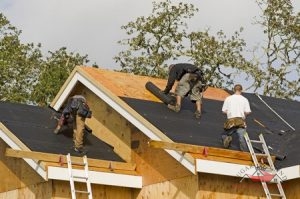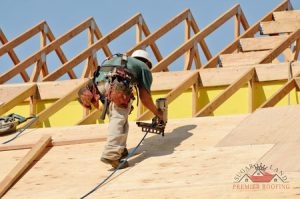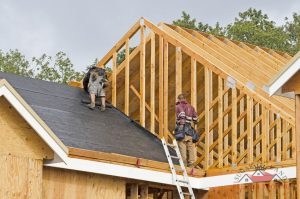
Strong, Well-Installed Roof Decking Is the Foundational Element of a Sturdy Roof.
What does roof decking mean you ask? Let Sugar Land Premier Roofing help you out! Roof decking, also known as roof sheathing, acts as the foundation of your roof. As the bottom layer of your roof, decking is attached to the rafters, and eventually supports the entire weight of the finished roof.
It also secures the positions of the rafters to keep them evenly spaced. In this regard, your decking ensures the structural integrity of your roof and, by extension, your home. While it was once common for buildings to have a roof without decking, this structural element now represents a standard component of just about any home. In the absence of decking, roofs sag, rafters shift, and the roof becomes vulnerable to failure through a cave-in. Decking also serves as the point of attachment for your waterproofing membrane.
Mention of the waterproofing membrane brings up an important point: roof decking, like anything made of wood, is vulnerable to the effects of moisture. A slab leak can damage your foundation and impact the stability of your home. A leak in your roof can accomplish the same from the opposite direction, as it will damage the decking and reduce its strength.
With a well-designed roof, the roofing material and waterproofing membrane protect the decking from rainfall. If either of these become damaged, however, or if water manages to sneak past your flashing, the resultant roof leak can rot your decking and threaten its integrity. To protect your roof decking, make sure to call a trusted roofer at the first sign of a leak.
What is Roof Decking Made of?
An understanding of roof decking’s purpose can serve to inspire a homeowner to take care of this integral structural component. If you have a new construction home, or one that necessitates total roof replacement, you’ll need to make an educated decision about the type of decking to choose. Before you select from available options, you should understand the various qualities of the two major materials used for decking: plywood and oriented strand board (OSB).

Both Plywood and OSB Are Commonly Employed as Decking Materials.
Once upon a time, plywood ruled the roost in terms of sheathing and subflooring materials for homes and other structures. This has changed dramatically, and now more than 75 percent of new structures employ OSB instead of plywood. While you may naturally assume that OSB represents some kind of technological breakthrough, it does not.
In fact, price represents the main reason most builders choose OSB over plywood. Though the price of building materials is highly volatile, OSB typically costs $3 less per sheet. For the average construction project, this can result in a great deal of savings. Costs aside, there do exist important differences between OSB and plywood that homeowners and builders alike should understand.
Which Is Better OSB or Plywood?
It’s impossible to state unequivocally that one of these materials outclasses the other, though people will naturally have their opinions. To make your own choice, you should simply consider the relative benefits of each. OSB comes with the following advantages:
- Low Cost
- Sustainable Production Methods
- Comes in Larger Sizes, Which Means Fewer Seams
- Consistent Density
The low cost of OSB is well-known, and provides the main reason for the preferences of most builders. OSB also has a sustainable production method, as it is manufactured from fast-growing trees raised on dedicated tree farms. OSB also comes in panels as wide as 16 feet, which means fewer panels used for each job. This reduces the number of seams in your decking, which makes it more difficult for water to enter your home or business.
As for the more consistent density, this is another effect of OSB’s manufacturing. OSB is made from layers of thin, wooden strips bonded and compressed with wax and synthetic resin. This gives it a higher density that is not disturbed by the presence of knotholes or any other natural irregularities associated with plywood.
A low price, higher density, and sustainable manufacturing process likely makes OSB appear the clear winner between itself and plywood. However, plywood does have its own advantages, including:
- Lighter Weight
- Slightly Better Rigidity
- Resistance to Moisture
The lighter weight of plywood means it places less stress on a home’s rafters and other structural components. It also makes for an easier installation job, as heavy OSB panels are sometimes difficult to lift and maneuver. Slight improvements to rigidity also mean you can use thinner panels of plywood for applications like flooring. The main edge that plywood has over OSB, however, is the way it interacts with moisture.
Plywood absorbs moisture evenly, swells up, then dries out and returns to its original shape. OSB, on the other hand, takes longer to dry out, and can warp. This becomes an important consideration for construction projects that may encounter delays, since building materials are often stored outdoors. It also means your decking will suffer less damage in the event of a water leak.
Roof Decking FAQ

Roofers Will Often Install a Membrane on Top of Roof Decking to Make it More Waterproof.
What Is Used for Roof Decking?
Oriented strand board (OSB) has 75 percent of the roof decking market share. Of the remainder, plywood is by far the most widespread. Occasionally, you will also see normal wooden boards used for decking. However, these are tricky to install correctly, and provide no real benefits.
Is Roof Decking Treated?
Both types of the primary roof decking materials are commonly treated for water resistance. These cost more than untreated versions, however. If you live in a humid climate, or one prone to frequent rainfall, you should go ahead and invest the extra money into treated decking. If you live in a more arid environment, untreated decking presents an opportunity to save some cash.
How Thick Does Roof Decking Need to Be?
The minimum recommend thickness of decking is 3/8-inch. In modern construction, however, you are more likely to find 1/2-inch or even 5/8-inch decking. Thicker decking becomes more important for low-slope roofs, as the decking must hold more weight.
What Length Roofing Nails Should I Use? Should Roofing Nails Go Through the Sheathing?
Roofing nails must have a minimum length substantial enough to penetrate the roofing materials and enter at least 3/4-inch into the sheathing. Since most sheathing is less than 3/4-inch thick, this means that the nails should protrude from the underside of the sheathing. This accomplishes a more stable attachment of the roofing materials to the sheathing, and makes your roof less susceptible to certain problems, including high winds.
At SLPR, we’re the local experts for any need you might have with roof decking. For repair needs, installation, or the replacement of old or rotted decking, we offer exceptional service and fair, affordable pricing. To ask any questions or schedule service, give us a call today at 832-581-9234.

